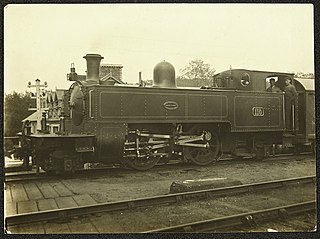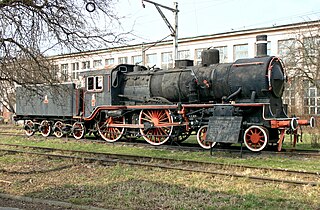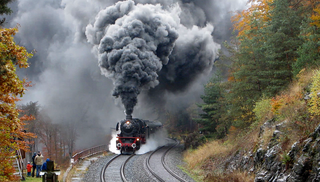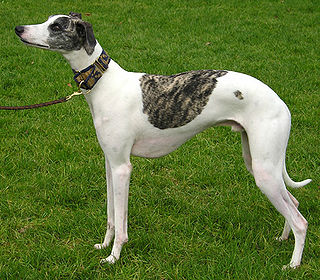The Highland Railway began as the Inverness and Nairn Railway, which operated the other lines which became part of the Highland Railway on its formation in 1865. For post-1870 locomotives, see Locomotives of the Highland Railway.

The London, Midland and Scottish Railway (LMS) Royal Scot Class is a class of 4-6-0 express passenger locomotive introduced in 1927. Originally having parallel boilers, all members were later rebuilt with tapered type 2A boilers, and were in effect two classes.

The London Midland and Scottish Railway (LMS) Fowler 3F 0-6-0T is a class of steam locomotive, often known as Jinty. They represent the ultimate development of the Midland Railway's six-coupled tank engines.
Southern Pacific Company's MM-2 class of steam locomotives was Southern Pacific's (SP) only class of 2-6-6-2 locomotives ordered and built as oil-fired cab forward locomotives. They were built in 1911 as compound-expansion Mallet locomotives by Baldwin Locomotive Works and entered service on SP beginning September 19, 1911. By 1914, they had all been upgraded with an additional leading axle making them 4-6-6-2 locomotives, reclassified from MM-2 to AM-2. This was done to improve handling at speed. These locomotives were the predecessors of several other cab-forward engines, culminating in the AC-12 class cab forward locomotives built during World War II.

The NCC Class WT is a class of 2-6-4T steam locomotives built by the Northern Counties Committee's parent company, the London, Midland and Scottish Railway for service in Northern Ireland.
The LMS Northern Counties Committee (NCC) Class Y was a class of 0-6-0T steam locomotives formed when two LMS Fowler Class 3F engines were regauged from 4 ft 8 1⁄2 instandard gauge to the 5 ft 3 in Irish broad gauge in 1944 becoming NCC Nos.18 and 19.
The Belfast and Northern Counties Railway (BNCR) Class A was a class of 13 two-cylinder compound steam locomotives built for service in north-east Ireland. The first two members of the class would be the last locomotives to be built for the independent BNCR, being completed before its purchase by the Midland Railway in 1903. The members of the class were rebuilt by the LMS (NCC) becoming either Class A1 or Class U2 depending on how they had been modified.

The Northern Counties Committee (NCC) Class U2 4-4-0 passenger steam locomotives consisted of 18 locomotives built for service in north-east Ireland. Ten of the engines were new builds supplied by the North British Locomotive Company (NBL) or constructed at the NCC's York Road works. The remainder were rebuilds of existing locomotives.

The Belfast and Northern Counties Railway (BNCR) Class S was a class of 2-4-2T two-cylinder compound steam locomotives that was introduced for service on the 3 ft narrow gauge railways of County Antrim in north-east Ireland.

The 517 Class were small 0-4-2T tank engines designed by George Armstrong for local passenger work on the Great Western Railway. They were built at Wolverhampton Works and were outshopped between 1868 and 1885. They were built in thirteen lots commencing with 517–528 and ending with 1477–1488 in 1884–1885.
The Northern Counties Committee (NCC) Class S1 was a class of two-cylinder compound 2-4-2T steam locomotives that was introduced for service on the 3 ft (914 mm) narrow gauge railways of County Antrim in north-east Ireland. The members of the class were rebuilds of the BNCR Class S.
The Northern Counties Committee (NCC) Class S2 was a solitary two-cylinder compound 2-4-4T steam locomotive that was introduced for service on the 3 ft (914mm) narrow gauge railways of County Antrim in north-east Ireland. It was heavily rebuilt from a BNCR Class S locomotive by the addition of a standard gauge boiler.
The LMS Class A1 4-4-0 passenger steam locomotives were rebuilds of Belfast and Northern Counties Railway Class A two-cylinder compound locomotives. They operated services throughout the NCC’s 5 ft 3 in broad gauge system in the north-east of Ireland.
The Belfast and Northern Counties Railway (BNCR)Class B was a class of 4-4-0 two-cylinder compound steam locomotives that was introduced for passenger service in the north-east of Ireland during the late 1890s.
The Belfast and Northern Counties Railway (BNCR) Class N was a class of 0-4-0ST dock engines that worked on the Belfast Harbour Commissioners' lines in north-east Ireland. No.42 was the first of the class and was built by Sharp, Stewart and Company in 1874. A second, similar engine, No.16, was built by the MR (NCC) in 1914.

The Prussian S 6 was a class of German steam locomotive with a 4-4-0 wheel arrangement operated by the Prussian state railways for express train services.
The Victorian Railways V Class is a steam locomotive, used on the Victorian Railways in the period 1900-1930.

The NER Class R1 was a class of 4-4-0 steam locomotives of the North Eastern Railway. The class was designed by Wilson Worsdell and built from 1908 to 1909.












